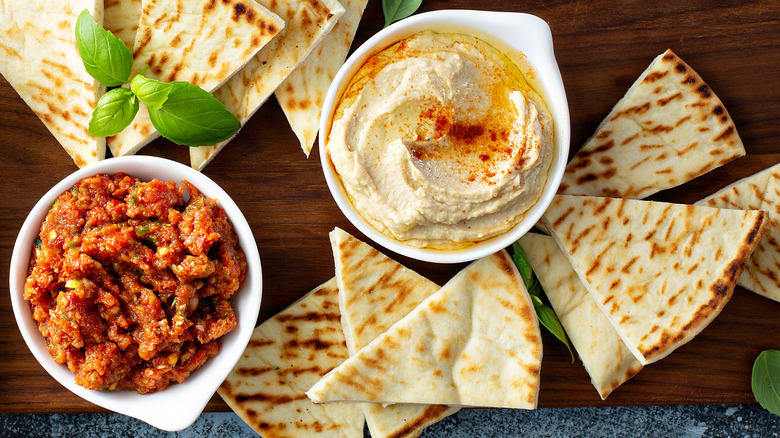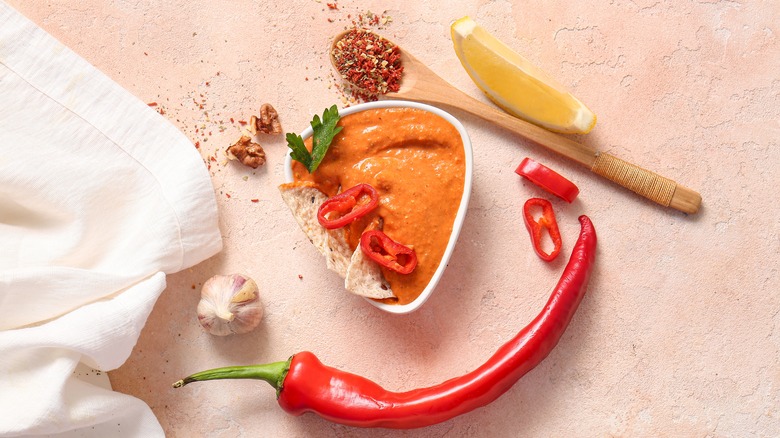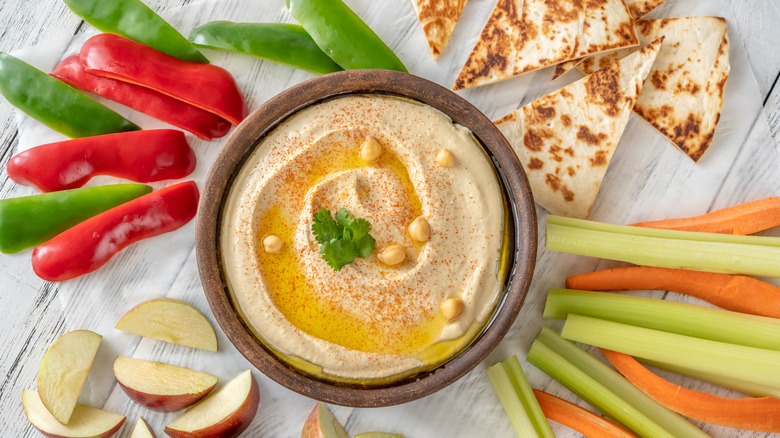Muhammara Vs Hummus: The Difference Between These 2 Dips
When enjoying a mezze platter, the dips are the star component that make the dish truly shine. These creamy, flavor-rich Mediterranean pastes like hummus and muhammara are delicious both as accompaniments and centerpieces to a meal. They can elevate everything from Greek grilled chicken pitas to classic sandwiches, though even serving as a humble dip they can really add to a dish.
While both are dips and have similar nomenclature, how much do muhammara and hummus really have in common? Though they both have Mediterranean origins and are sometimes even served together, there are notable differences between these two dips that set them apart from one another, particularly in their core ingredients. As tasty as many modern variations of hummus can be, including hummus with white beans and even butternut hummus, we'll want to compare the two dips in their most basic form. The main difference, when it comes to basic ingredients, is that while hummus is made of chickpeas and tahini, muhammara is mainly composed of nuts and red peppers.
What is muhammara?
Muhammara is a Mediterranean dish that is believed to have originated in Syria, specifically Aleppo, but also has roots in Turkey. It is a dip that contains pureed spicy red peppers and nuts, typically roasted red pepper (and/or Aleppo pepper) and walnuts. Muhammara means reddened in Arabic, with red peppers providing the bright maroon shade of its namesake. Other common ingredients in the dish include cumin, oil, garlic, lemon juice, and pomegranate molasses.
In terms of its components (nuts and red peppers), muhammara has more in common with other similar sauces in other cultures than with hummus. These include romesco sauce, which is a Spanish sauce made of almonds along with roasted red peppers and tomatoes, as well as salsa de calçots (salvitxada), which is almost identical to romesco. Though while salvitxada is typically served with leeks, muhammara is served in mezze platters and with pita, but can be eaten with vegetables, meat, or even fish. However, a mezze platter isn't complete without a hummus accompaniment.
What is hummus?
Hummus is a Middle Eastern dish that consists of mashed chickpeas and tahini (toasted sesame paste) and often includes additional ingredients like oil, lemon juice, cumin, salt, and garlic (though there are many other additions to take your hummus up a notch). Similar to muhammara, the name is based on an Arabic word (hummus means chickpeas). It is also believed to have Syrian origins just like muhammara, as a 13th-century Aleppo cookbook contains an early recipe for hummus. However, there are other theories about where hummus originated, including a vague reference in the Hebrew Bible and a mention in early Egyptian cookbooks of recipes for a chickpea paste similar to hummus.
It is typically served with pita bread or falafel and can be used both as a dip or main dish. Because hummus has a much milder flavor than muhammara, other ingredients and flavors are often incorporated into the dip, and a significant amount of variations on the paste have been developed. One of the most common hummus variations is red pepper hummus, which incorporates red peppers like muhammara while keeping its chickpea base. While similar in origin, the two dips have entirely different components, but fortunately, can both be found on the same mezze platter for a flavorful tasting experience.


